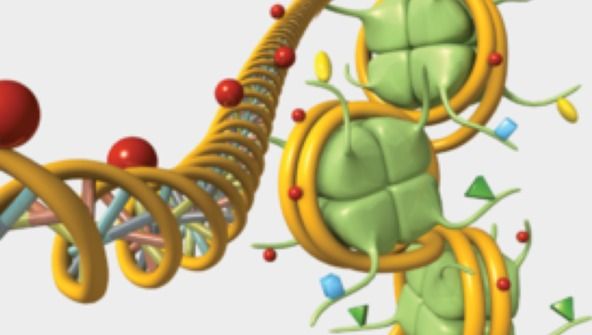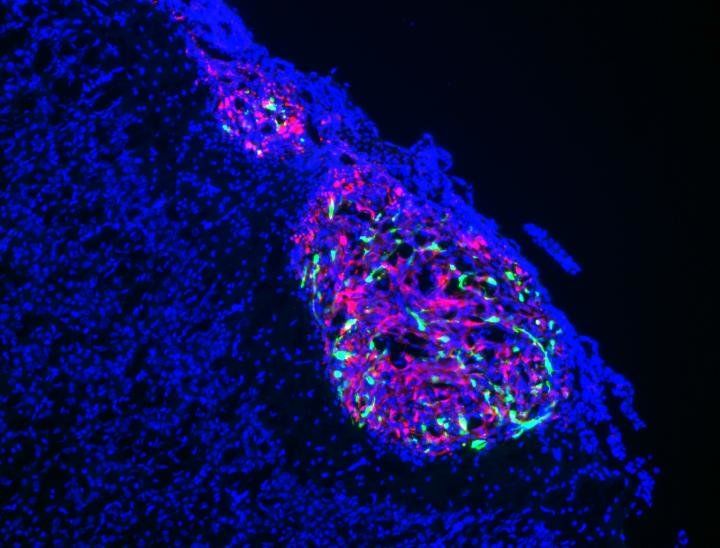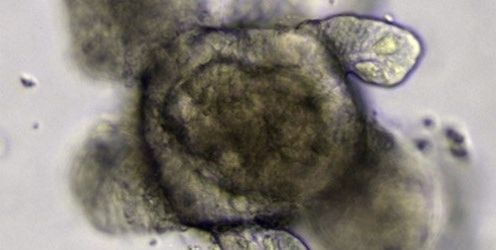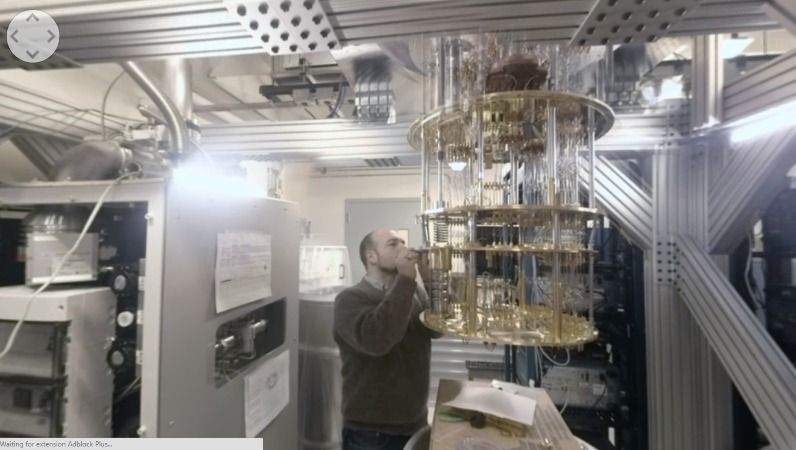Archive for the ‘genetics’ category: Page 492
May 13, 2016
FDA fast-tracks treatment that uses polio virus to fight brain cancer
Posted by Karen Hurst in categories: biotech/medical, genetics, neuroscience
Very nice.
The Food and Drug Administration has given so-called “breakthrough” status to a treatment that uses the once-feared polio virus to target aggressive forms of brain cancer, in the hope of speeding it to market.
The therapy, developed at Duke University, hopes to use the virus’ debilitating properties to help fight cancer instead of harming its host, CBS News reported Thursday.
Continue reading “FDA fast-tracks treatment that uses polio virus to fight brain cancer” »
May 13, 2016
Gene therapy against brain cancer
Posted by Karen Hurst in categories: biotech/medical, genetics, health, neuroscience
Very promising. I hope within the next 10 years that Glioblastoma is eradicated.
A team from the International School for Advanced Studies (SISSA) in Trieste has obtained very promising results by applying gene therapy to glioblastoma. Tests in vitro and in vivo on mice provided very clear-cut results, and modelling demonstrates that the treatment targets at least six different points of tumour metabolism. Gene therapy, a technique that selectively attacks a tumour, might provide hope in the fight against this type of deadly cancer, for which surgery is practically impossible and chemo- and radiotherapy are ineffective against very aggressive recurrences. The study was published in the journal Oncotarget.
Only a few days ago, the press (especially in English-speaking countries) enthusiastically announced the publication of a study that described in great detail the genetics of breast cancer, a discovery that according to many marks a breakthrough in the battle against this cancer. This kind of news confirms the impression that in the near future the war against cancer will be fought on the battlefields of genetics. Italy too, is working on this front. At SISSA, for example, where Antonello Mallamaci and his group have just published highly promising results on the application of gene therapy against glioblastomas, a family of brain tumours among the most common and aggressive. A diagnosis of glioblastoma is literally equal to a very imminent death sentence: “surgery is rarely curative, as these tumours insinuate themselves in healthy tissues, and also chemo- and radiotherapy have little effectiveness.
May 12, 2016
Gene expression depends on aonstant dialogue between nucleus, cytoplasm
Posted by Karen Hurst in categories: biotech/medical, genetics
Gene expression is the process by which genetic information is used to produce proteins, which are essential for cells to function properly and fulfil their many purposes. It takes place in two distinctive steps: first the transcription, which takes place in the nucleus, then the translation, in the cytoplasm. Control of gene expression is vital for cells to produce the exact proteins that are needed at the right moment. Until now, gene transcription and translation into proteins were thought to be two independent processes. Today, microbiologists at the University of Geneva (UNIGE), Switzerland, and at the European Molecular Biology Laboratory in Heidelberg (Germany) provide additional evidence that these two processes are intrinsically related and show that a protein complex called Ccr4-Not plays a key role in gene expression by acting as a messenger between the nucleus and the cytoplasm. Published in Cell Reports, these results shed light on the very mechanisms governing gene expression, a process that controls the life and death of our cells.
Gene expression refers to the biochemical processes through which the information that is stored in our genes is read like an instruction book to produce proteins that will make our cells function properly. Until now, gene expression was thought to take place in two distinctive steps: first transcription, which takes place in the nucleus, then translation, in the cytoplasm. Today, research led by UNIGE and the European Molecular Biology Laboratory shows that transcription and translation are intrinsically related and continuously influence one another. To do so, a very efficient communication within the cell, between the nucleus and the cytoplasm, is essential. This dialogue is made possible by a protein complex called Ccr4-Not, which globally determines the cell translational capacity.
Gene expression: a two-way street
Martine Collart and her team from the UNIGE Faculty of Medicine discovered in 2014 that the Ccr4-Not complex enables the cytoplasm to provide information to the nucleus during translation. Today, they prove that it is a two way-street communication as the nucleus also communicates information to the cytoplasm at all stages of gene expression, thanks to Ccr4-Not. This complex acts as a messenger between the nucleus and the cytoplasm to ensure that both transcription and translation levels are well adapted. It is also able to enhance translation to compensate for transcriptional stress, thus ensuring that gene expression remains well-balanced.
May 12, 2016
Cancer cells escape when they block this gene
Posted by Karen Hurst in categories: biotech/medical, genetics, health
I remember years ago when researchers identified that families with high rates for severe allergies also had high rates of cancer. Today, we talk about cancer and immunology as an intertwined dependency. Just means we’re still understanding cancer, genetic mutations, and the trigger/s in causing cancer among families and individual.
Scientists say the NLCR5 gene allows cancer cells to escape the immune system. A test for the biomarker may predict how long a cancer patient can survive.
May 7, 2016
Oxford Scientists Made A Pocket-Sized, Portable DNA Sequencer
Posted by Shailesh Prasad in categories: biotech/medical, genetics, mobile phones

Oxford Nanopore Technologies is changing the course of genomics through the development of their small and portable DNA sequencer, the MinION, which makes of nanopore technology.
The handheld, portable tricorder from Star Trek was essentially able to scan and record biological data from almost anything, and it could do it anytime and anywhere. Recent technology has been pulling the device out of science fiction and turning it into reality, but none have come close to getting genetic information with the same portability…except for British company Oxford Nanopore Technologies.
Continue reading “Oxford Scientists Made A Pocket-Sized, Portable DNA Sequencer” »
May 6, 2016
With CRISPR, Modeling Disease in Mini Organs
Posted by Karen Hurst in categories: biotech/medical, genetics
Organoids grown from genetically edited stem cells are giving scientists a new tool to screen drugs and test treatments.
May 5, 2016
Gene replacement therapy offers viable treatment option for fatal disease
Posted by Karen Hurst in categories: biotech/medical, genetics
New cure for SMA?!
Spinal muscular atrophy (SMA) is a disease that causes progressive degeneration in the nerve cells that control muscles, thereby causing muscle weakness and eventually death. SMA affects approximately 200,000 people in the U.S., often children. Now, researchers at the University of Missouri are studying a subtype of SMA, spinal muscular atrophy with respiratory distress type 1 (SMARD1), and have developed a gene replacement therapy that can be used to treat and control the disease in the future.
SMARD1 is a rare genetic condition with high mortality rate that develops primarily between the ages of six weeks and six months. The condition targets the spinal cord and leads to atrophy of body muscles and paralysis of the diaphragm, which is responsible for breathing. As the disease progresses, children with a SMARD1 diagnosis become paralyzed and require continuous artificial ventilation. The average life expectancy of a child diagnosed with SMARD1 is 13 months. Currently, there is no cure or effective treatment for this disease.
“Monogenic diseases like SMARD1, a disease that is caused by one gene, are ideal for gene therapy since the goal of the therapy is to replace the missing or defective gene,” said Chris Lorson, an investigator in the Bond Life Sciences Center and a professor of veterinary pathobiology. “Our goals for this study were to develop a vector that would improve the outcomes of the disease and for the vector to be effective in a single dose.”
May 5, 2016
The Brilliantly Insane Plan to Reconstruct Leonardo da Vinci’s Genome
Posted by Sean Brazell in categories: biotech/medical, genetics, media & arts
The more da Vinci’s the better, if you ask me!
An international team of scholars has just unveiled plans to science the shit out of Leonardo da Vinci, the man who gave us the Mona Lisa and envisioned futuristic technologies like helicopters and tanks 500 years ago. Goals of the fledgling “Leonardo Project” include recovering the famous Renaissance figure’s remains and reconstructing his genetic code.
The Leonardo Project brings together geneticists, genealogists, archaeologists, and art historians from Italy, Spain, France, the United States and elsewhere. “This is a fabulous, interdisciplinary project,” said Rhonda Roby, a geneticist at the Craig Venter Institute in California, who will be contributing its expertise in genomic reconstruction to the effort.
Continue reading “The Brilliantly Insane Plan to Reconstruct Leonardo da Vinci’s Genome” »
May 4, 2016
What IBM’s new quantum processor means for the future of computing
Posted by Karen Hurst in categories: computing, genetics, quantum physics, robotics/AI
Here is the impact of today’s IBM QC announcement & if proven real then the following will certainly be fasttracked:
1. IBM is now ahead of everyone in QC
2. China & Russia are now going to heat up their own QC efforts.
Continue reading “What IBM’s new quantum processor means for the future of computing” »















